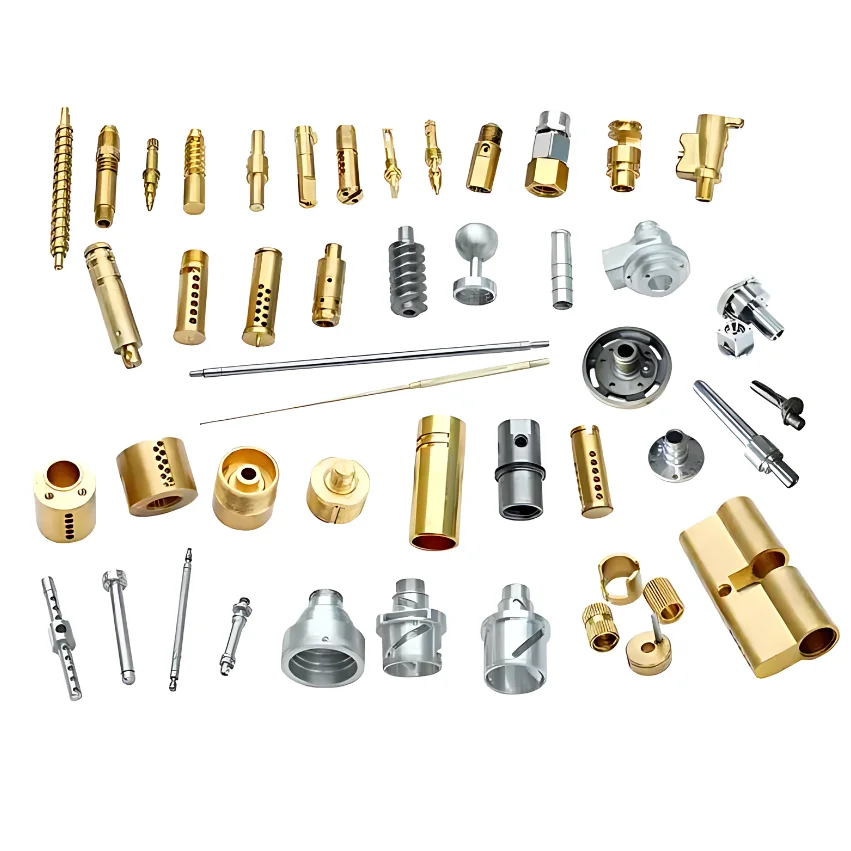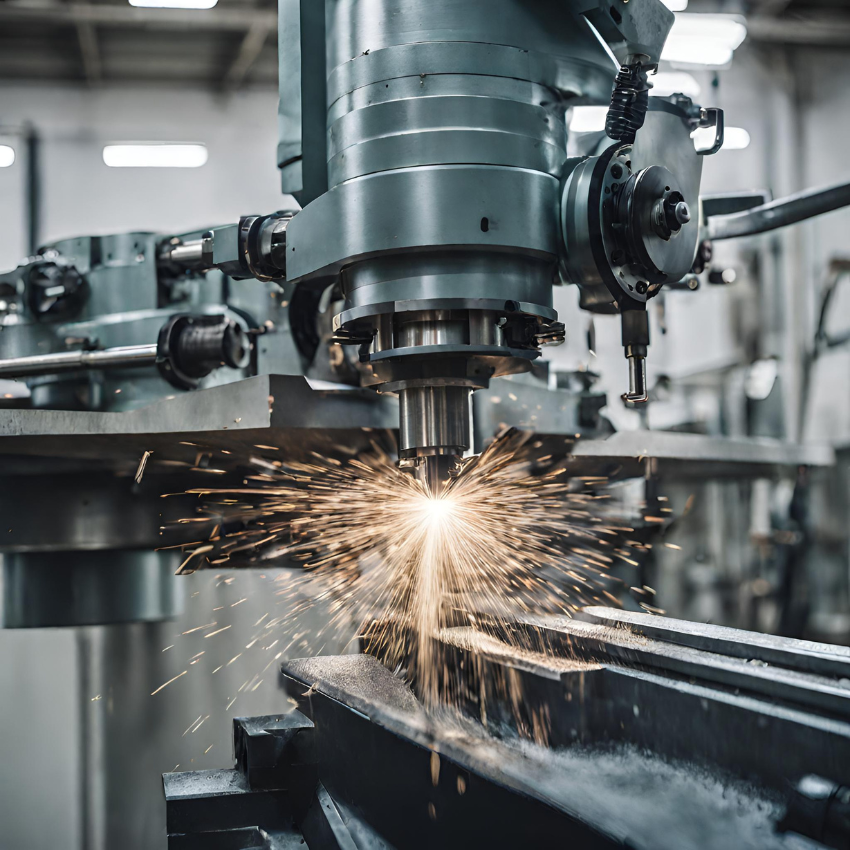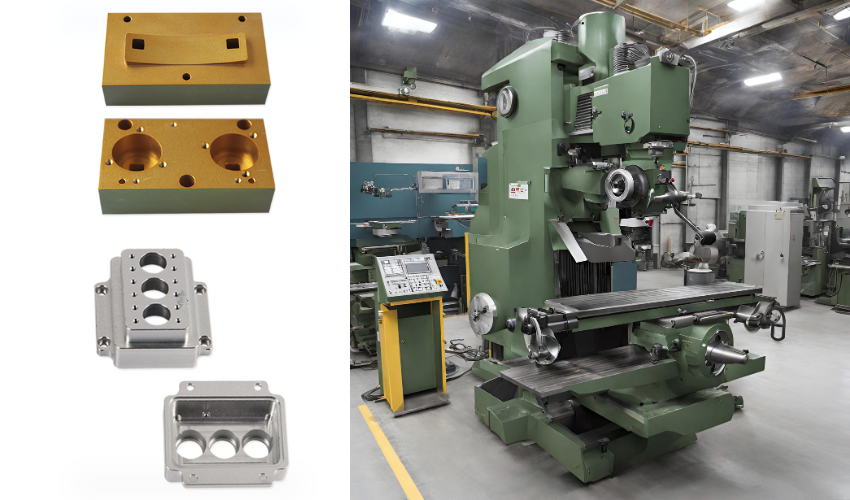It’s hard to believe that milling machines have been a cornerstone of manufacturing for more than 300 years! Since Eli Whitney introduced the first milling machine in New Haven, Connecticut in 1818, we have seen an incredible transformation. From the initial replacement for slow, painstaking hand filing, to today’s highly sophisticated operations that are faster and more accurate than anyone could have imagined.
Today, the capabilities of milling machines have greatly expanded to allow for a range of operations, each tailored to meet specific manufacturing needs. This article will take an in-depth look at ten types of milling operations.
What is Milling?
During milling, the cutting tool or the workpiece moves along the cutting path to create complex shapes. In metal milling, the workpiece sits on a table or fixture while a high-speed rotating cutting tool, like an end mill or face mill, removes material.
When the tool comes into contact with the workpiece, its cutting edge slices away material to create the desired features, contours, and shapes. Both the cutting tool and the workpiece can move along multiple axes, allowing for the machining of flat surfaces, complex contours, holes, threads, and intricate shapes.
Metal milling is capable of machining features in a wide variety of metals due to its high level of accuracy. It is widely used in industries such as aerospace, automotive, manufacturing, and engineering.
If you need CNC milling services, you can hire us at Widetop. We have more than 20 years of experience in the industry and we can make sure that you get the highest quality parts at a low cost. You can contact us if you are in need.
12 Types of Milling Operations
Milling operations encompass a wide range of techniques tailored to specific applications and material properties. Let’s explore some common types of milling operations that are widely used in various industries.
Shoulder Milling
Shoulder milling is a precision machining method that uses side milling cutters equipped with multiple inserts or cutting edges to selectively remove material from the shoulder or side walls of a workpiece. Its primary purpose is to machine flat or contoured surfaces along the edge of the workpiece.
Shoulder milling is used in a wide range of industries, for example, shoulder milling can machine joints and slots in a variety of products. This adaptable technique uses a variety of milling cutters, each of which is customized for a specific shoulder milling task.
Face Milling
Face Milling is designed to create a flat surface on a workpiece and is typically performed using a face milling cutter with multiple cutting edges. The face milling cutter rotates and moves along the surface of the workpiece, and the cutting edges of the tool gradually remove material from the surface of the workpiece, resulting in a smooth, precise surface finish.
In automotive manufacturing, Face Milling is often used to machine critical components, such as engine blocks, to ensure precise edges and flat surfaces.
Profile Milling
Profile Milling is the use of cutting tools to create complex contours and shapes on a workpiece along a predetermined path. This milling operation is often used to produce complex parts with specific profiles, such as gears, contours, and irregular surfaces.
Slot Milling
Slot milling is a basic technique for machining slots or grooves in a workpiece. The process utilizes specialized slot milling cutters to eliminate material and form slots of varying depths and widths.
Slot milling can be used to manufacture mechanical parts such as gears, bearings, and couplings.
End Milling
End Milling uses a cutting tool with multiple teeth to remove material from the end of a workpiece. This versatile milling operation creates flat surfaces, contours, and intricate designs on the end of the workpiece. End Milling is used to manufacture mechanical parts such as bearings, threads, and holes. Used in the automotive manufacturing industry for machining engines, drivelines, body parts, etc.
Thread Milling
Thread milling is used to create internal or external threads on a workpiece. The process involves the use of a thread milling cutter that removes material in a helical motion, creating precise and uniform threads with exceptional accuracy. Thread milling is often used to produce threaded parts such as nuts, bolts, and screws.
Side Milling
Side milling uses side milling cutters to remove material from the side of the workpiece. In this method, a flat surface or contour is machined along the side of the workpiece. Side milling plays a role in creating keyways, slots, and other features that require precise side-to-side machining.
Saw Milling
Saw milling is the use of a saw-like cutting tool to remove material from a workpiece. It is commonly used in woodworking and metalworking for cutting large pieces or shaping specific contours. Saw milling effortlessly cuts straight lines, curves, angles, and intricate designs, making it ideal for applications where traditional rotary cutters are less effective.
CAM Milling
CAM milling utilizes CAD (Computer Aided Design) and CAM software to generate tool paths and control the movement of the cutting tool. It enables high-precision, highly repeatable machining and the ability to work with a wide variety of shapes and surfaces, such as curves, surface contours, and 3D structures.
CAM milling is used in the aerospace industry for turbine blades and engine components. It is used to produce prosthetics, implants, and surgical instruments for medical devices.
Form Milling
Forming milling is used to machine complex shapes and contours on workpieces. Form milling is commonly used to produce parts with non-linear geometries, such as molds, dies, and engraved surfaces. Forming milling cutters follow a pre-determined path to shape the workpiece to specific design requirements, ensuring uniformity and accuracy of the machined contour.
Straddle Milling
Straddle milling machines on two parallel surfaces on a workpiece simultaneously. The cutting tool moves along both surfaces, cutting them at once. This method is common for making symmetrical workpieces requiring identical features on parallel surfaces, like flat joints, parallel rails, gears, and other parts.
Plain Milling
Flat milling is mainly used to create a flat surface on a workpiece. In flat milling, the workpiece is mounted on the table of the milling machine, and the milling cutter is mounted on the spindle. The milling cutter rotates and moves along a trajectory on the surface of the workpiece, gradually cutting the material to form a flat surface. Flat milling can be used in the automotive industry to machine parts such as engine cylinder heads, bases, and connectors.
Tips for Choosing the Right Milling Operation
There are many types of milling operations. How to select the right type of milling for you? Here are some suggestions for you:
Consider Material Properties
Evaluate the hardness, machinability, and thermal conductivity of the workpiece material.
Select milling techniques that are appropriate for specific material properties.Such as shoulder milling for hard metals and contour milling for soft materials.
Evaluate Workpiece Complexity
Analyze the complexity of the workpiece design and geometry.
Select the milling operation that is appropriate for the complexity of the part, e.g. contour milling for complex contours and face milling for simpler geometries.
Evaluate Machining Accuracy
Determine accuracy requirements for dimensional accuracy and surface finish.
Select a milling technique that meets the accuracy requirements. Such as thread milling for precision threads or CAM milling for complex geometries.
Match the Operation to the Material Type
Select thread milling to machine internal or external threads in a variety of materials.
Use side milling to create contoured surfaces and features on the side of the workpiece.
Learn about the different goals of saw milling, which shapes materials, and thread milling, which fulfills threading requirements.
Conclusion
In this blog, we will take an in-depth look at the different types of milling operations. Each milling operation offers unique capabilities for specific material properties, geometric complexity, and accuracy requirements.
By exploring the various technologies and specialized approaches available, professionals can make the best decisions in selecting the most appropriate milling operation for a particular application.
Read More:






